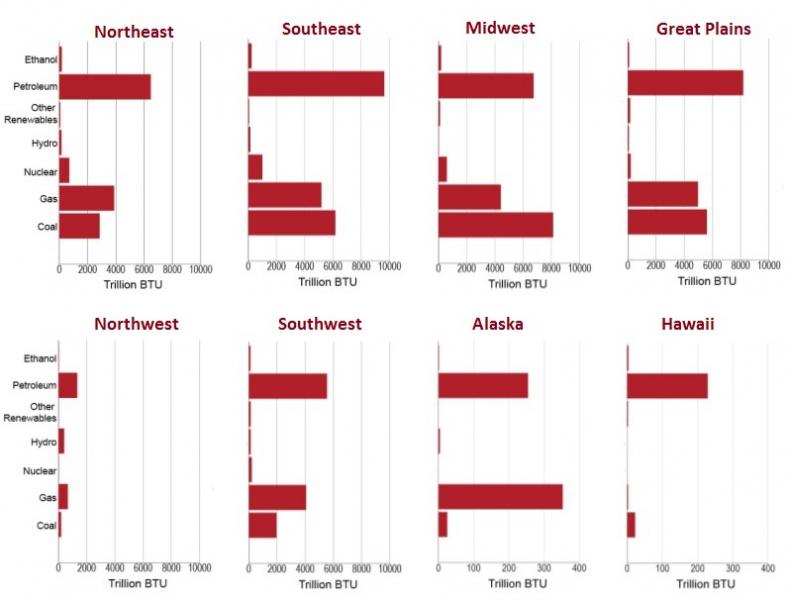
Energy
- Climate change will affect energy supply and use via changes in temperature, precipitation patterns, extreme weather events, and sea level rise.
- In response to higher temperatures and heat waves during summers, energy consumption will increase due to greater demand for air conditioning.
- In some regions, decreased availability of water for hydropower and for cooling thermoelectric power plants will reduce electricity generation. Increasing temperatures may also reduce the efficiency of electricity generation and transmission.
- Extreme temperatures, severe storms, sea level rise, and storm surge may cause disruptions in energy supply or damage to energy infrastructure.
- Potential measures to minimize climate-related impacts to energy supply and use include implementing changes in siting and operations planning, modifying or deploying new energy technologies and equipment, and decreasing energy demand.
Key points:
Risks to energy security
Climate change will affect energy supply and use within the United States. Though the supply of energy in the United States is diverse and robust, increased risks from climate change have the potential to affect energy security. To function consistently, communities and businesses must have access to reliable and affordable energy supplies. Disruptions to the nation’s energy supply can ripple through many aspects of modern life, including water supply, transportation systems, communications, economic development, health, and general comfort.
Energy production in the United States relies on a variety of sources. These include fossil fuels such as petroleum, coal, and natural gas, nuclear energy, and renewable energy such as solar, wind, hydropower, and biofuels. Energy infrastructure that facilitates our use of these sources include oil and gas wells, mines, dams, railways and train cars, and power plants throughout the country.
Nationally, the sources of electrical power generation in 2014 were coal (40 percent), natural gas (26 percent), nuclear power (20 percent), hydroelectric (7 percent), wind (5 percent), biomass (1 percent), geothermal energy (<1 percent), and solar energy (<1 percent). Energy sources vary regionally, but fossil fuels are the major source in all regions. Aside from fossil fuels, nuclear power provides a moderate amount of energy in the East and hydropower provides a moderate amount of energy in the Northwest. Renewable sources of energy still represent a small portion of the total energy produced in all regions.
A major component of energy supply is the delivery of energy from producers to consumers. National and regional networks distribute raw materials from mines and wells to processing plants and utilities, and local networks distribute electricity and processed fuels to consumers. The system is large, complex, and interdependent. More than 140,000 miles of railways are used to move crude petroleum, refined petroleum products, liquefied natural gas, and coal across the country. Additionally, 2.6 million miles of pipelines, 414 natural gas storage facilities, and 330 ports handle crude petroleum and refined petroleum products. For delivery to consumers, the country has more than 642,000 miles of high-voltage transmission lines, and 6.3 million more miles of distribution lines. Climate-related disruptions to any of these systems can increase costs and/or interrupt services to consumers.
Climate change and energy
Climate change and extreme weather events are already affecting energy consumption and supply. Heat waves have become more frequent and intense, especially in the West, and these events increase energy consumption due to greater use of air conditioning. Increased demand can also affect energy-generating facilities, increasing the frequency of blackouts and brownouts. Extreme weather events and water shortages can also interrupt energy supply.
As temperatures increase, additional changes are likely to affect the energy sector in the future. Throughout the country, climate projections suggest that hot days will become hotter and heat waves will last longer, exacerbating demand for energy to cool homes and workplaces. Under a scenario of continued increases in emissions, the hottest days in some regions will be up to 15°Fahrenheit warmer than current conditions.
Advanced preparation for changing conditions could increase the resilience of the energy sector or minimize impacts on consumers. For example, actions that reduce energy use would minimize some of the stresses on energy infrastructure. Improved siting and operations planning, modification of existing energy equipment, deployment of new energy technologies and equipment, and increased generation/transmission of energy could enhance climate resilience and provide more energy security.
The preceding text is excerpted and abridged from the following sources:
- Climate Change Impacts in the United States: The Third National Climate Assessment (Chapter 2: Our Changing Climate, Chapter 4: Energy Supply and Use, and Chapter 10: Energy, Water, and Land Use).
- U.S. Energy Sector Vulnerabilities to Climate Change and Extreme Weather.
- U.S. Energy Information Administration Monthly Energy Review.
To learn more about the impacts of climate change and variability on energy supply and use, visit the subtopic pages:



